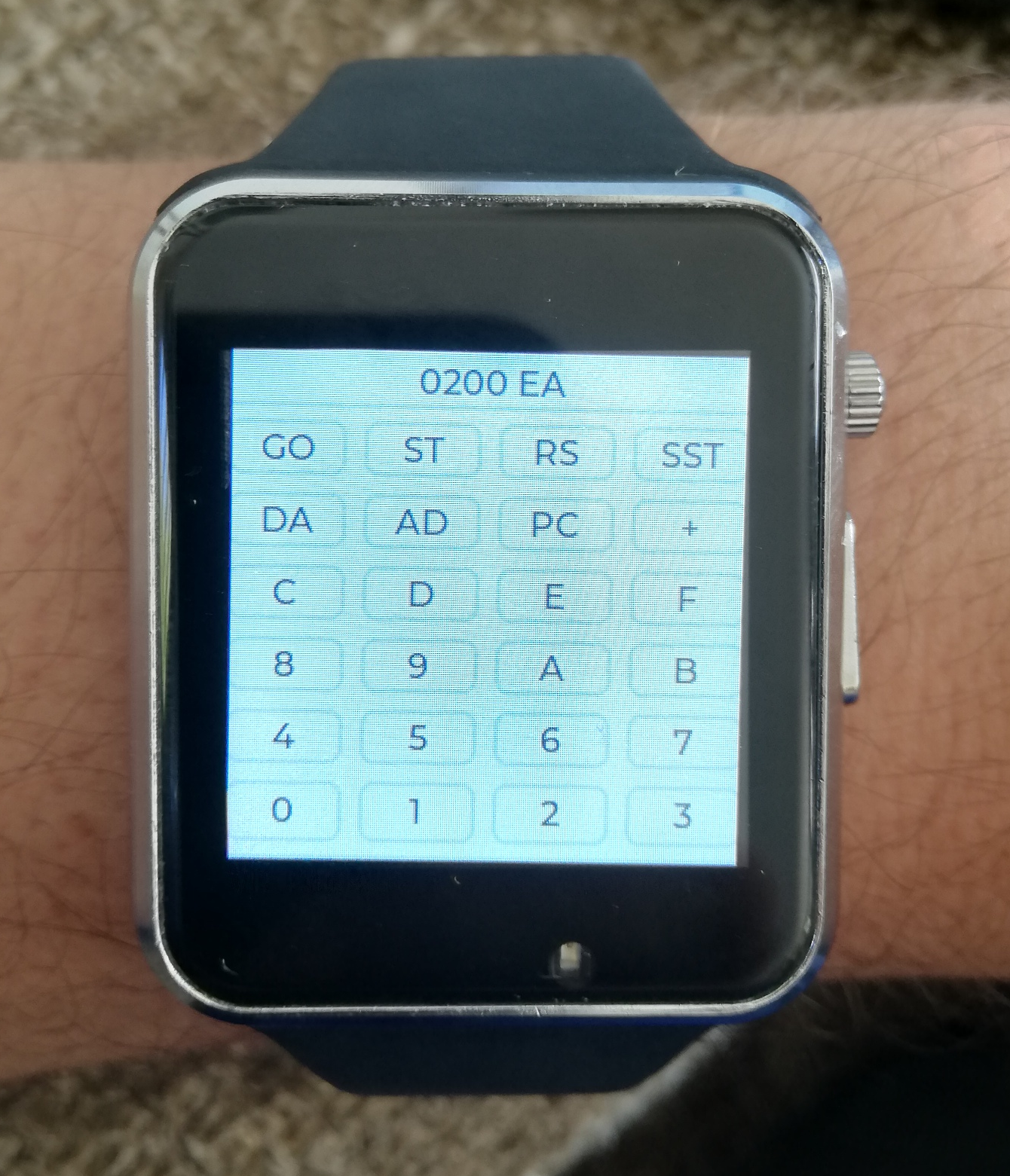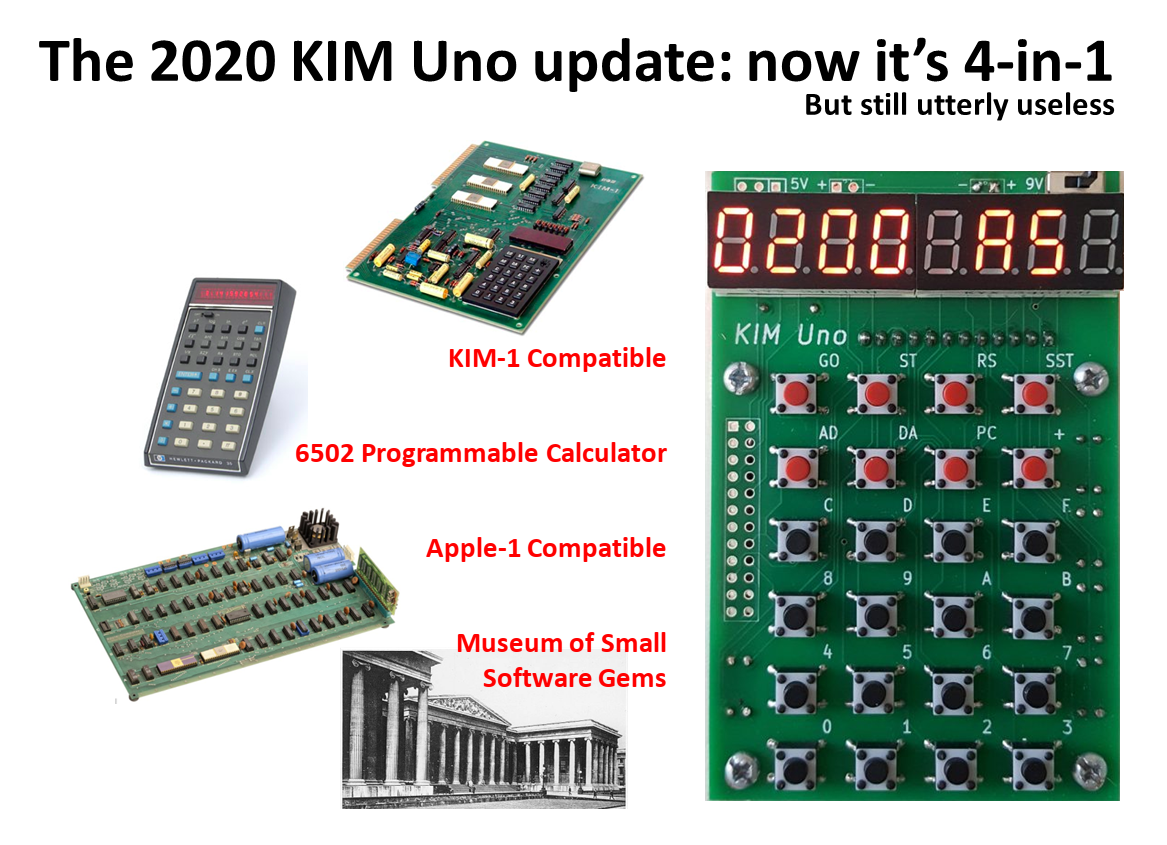-
Is that a KIM-1 on your wrist?
08/18/2020 at 07:21 • 1 commentQuarantaine silliness.
![]()
Because why not? This is the KIM Uno version for the TTGO T-Watch 2020, a very nice $28 package in the shape of a smartwatch that is really just an esp32 with lots of nice extras added. This version of the KIM Uno is just a quick hack, and really it's more the TTGO than my little hack that I recommend... but I'm tempted to develop it a bit more. Fun little platform!
-
Update: now it's 3-1: KIM-1, Apple-1 and 6502 programmable calculator
08/17/2020 at 21:46 • 0 commentsWell, 4-in-1: it's all about the built-in collection of tiny 6502 programming gems. The Pocket Museum.
It's been six years since I made the KIM Uno. For about $10 in parts cost, based on a hidden Arduino Pro Mini, its purpose (purpose?) is best summarised in a picture:
![]()
Inspired by my late, great friend Marcel van Kervinck, who hacked Apple-1 compatibility into just 930 logic gates with his Gigatron, this is my rather more modest attempt at Apple-1 fun, but it is pocket-sized. The software does not even need the PCB; all it takes is an Arduino, esp32 or STM 32 Blue Pill over a serial port.
The main benefit of the Apple-1 feature is that you can run WozMon and (thanks to some archaeology of Mike Barry) the Baum/Wozniak 850-byte mini-assembler. You can flip back between KIM-1 hex coding and the interactive mini-assembler with just a keypress. For when you don't know the hex code for that 6502 instruction.
The other updates: the EEPROM in the microcontroller now acts as solid-state cassette tape for storage.
And the code now runs on the more powerful Blue Pill and esp32 as well: I hit all the limits of the atMega328 (RAM, Flash, speed) and although I much enjoy shaving bytes off code to make things fit, it can't hold any more than it does now. Whilst the future of 6502 development, as is well-known, is a bright area of growth... All details & download on my KIM Uno web pages.
-
New firmware morphs KIM into an 1802 Cosmac Elf - with Pixie display
08/04/2017 at 01:10 • 1 commentAl Williams decided it was time to put an 1802 processor in the brain of the KIM Uno, morphing it into a Cosmac Elf. See his blog post here. Which triggered me to add a 1861 Pixie display to it. Using a $3 OLED, this now plays a nice set of vintage 1802 games - and thanks to Al's serial monitor code, it's a pretty mean and lean 1802 development environment. See my in-depth blog post for details.
Here's a quick Youtube video of the UNO1802.
That's all of $13 of parts in action... thanks, Al! Vintage computers never die.
-
Added VTL-02 interpreter
07/09/2016 at 00:57 • 1 commentVTL-02 is a nifty little programming language - 1020 bytes of code gives you something close to Basic. Written in 1976 for the Altair 6800 by Frank McCoy and Gary Shannon, it was only recently ported to the 6502 by Mike, and then tuned by Klaus, on the 6502 forum (link). It counts as one of the top early microcomputer programming achievements.
I was able to wedge it into the KIM Uno's ROM map, so it now boasts not only a machine language monitor and (Wozniak's original) disassembler, but also an easy-to-use interpreted language. Well, easy after you read the manual (here). It does require a serial terminal, or more likely a USB-to-Serial cable to your laptop used as a terminal. Because the on-board hex display really won't cut it :)
One more example of what you can do with less than 1024 bytes of code. And one more vintage 6502 coding gem in the KIM Uno. Thanks, Mike & Klaus!
The KIM UNO Firmware update is here, at the bottom of the page.
-
Compiling with Arduino 1.6
03/29/2015 at 18:10 • 0 commentsThe KIM Uno code was written for the 1.5 version. Scott tipped me off that you need to make one change when compiling under 1.6:
change "prog_uchar" to "const unsigned char" in cpu.
Thanks!
Oscar.
-
Convert dead calculators
03/16/2015 at 19:57 • 0 commentsScott over at http://geodesicsphere.blogspot.ch/2015/01/kim-uno.html modified the firmware to run on an old calculator display. Not published on his site yet, but he then proceeded to convert a dead calculator from the 70s. So I'm now looking for suitable transplantation candidates as well :)
KIM Uno: Simple KIM-1, Apple-1 & Cosmac Elf remake
A pocket-sized KIM-1/Apple-1/Cosmac Elf with added '6502 programmable calculator mode'. Parts cost is about $10.

